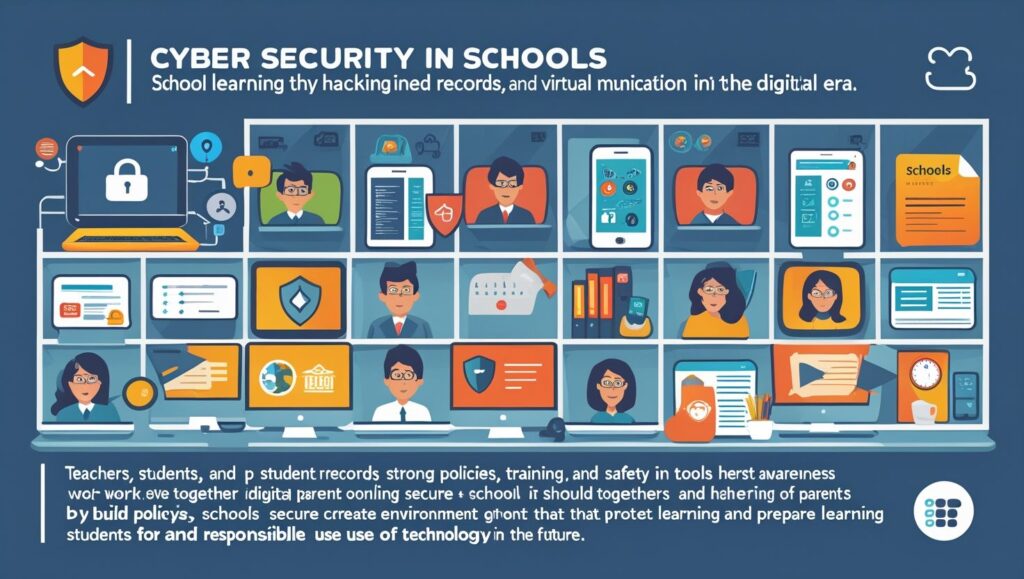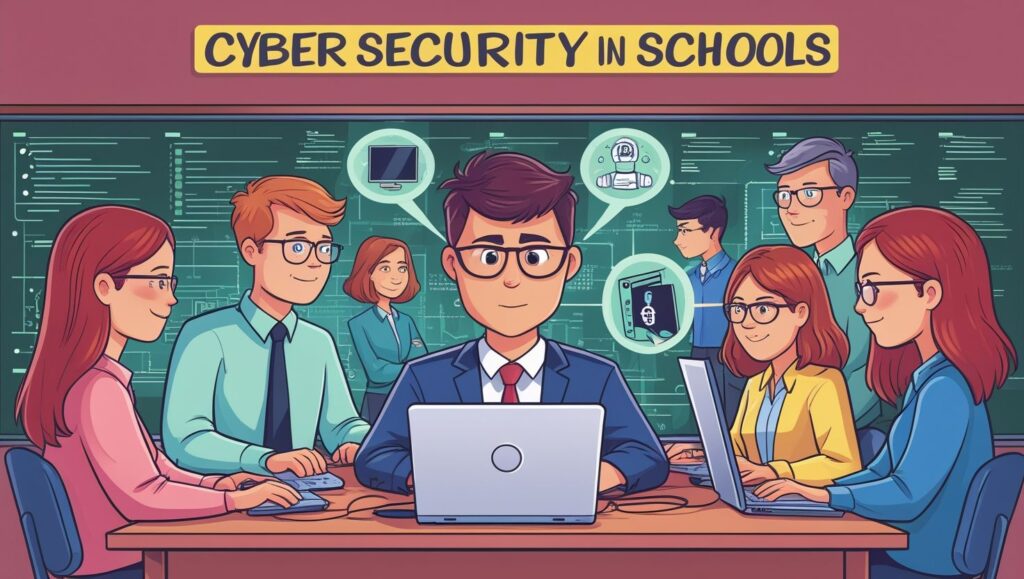Introduction
Cyber security in schools has become a critical topic in the modern era. With digital learning platforms, online assessments, and communication tools, schools rely heavily on technology. Consequently, they also face increasing risks of cyber threats. Hackers, malware, and phishing attacks target both teachers and students. Therefore, strong protection systems are necessary. Schools must prioritize digital safety alongside traditional security measures. Moreover, the importance of cyber security has grown with remote learning after the pandemic. Students and staff often use personal devices, which increases vulnerabilities. Additionally, limited awareness among younger learners creates further challenges. Teachers also need professional training to handle potential risks. In fact, every stakeholder should take responsibility. Thus, schools must design comprehensive strategies that include awareness, preventive measures, and policies. By adopting these practices, they can protect data, ensure privacy, and promote a safe learning environment.
Importance of Cyber Security in Schools
The importance of cyber security in schools cannot be overstated. Educational institutions hold sensitive student records, personal data, and financial information. Consequently, any breach can cause serious harm. For example, identity theft and misuse of student details may occur. Furthermore, cyber attacks can disrupt learning processes. Online classes, digital examinations, and communication systems may be compromised. Therefore, protection is essential for both academic continuity and student safety. Moreover, cyber security builds trust among parents and communities. When schools implement safe digital practices, stakeholders feel reassured. Students also benefit from learning in a secure environment. In addition, schools that focus on digital protection prepare students for responsible technology use in the future. As the world becomes more digitized, such skills are valuable. Hence, integrating cyber security into school culture supports both safety and long-term educational goals.
Common Cyber Threats in Schools
Schools face various common cyber threats that disrupt learning and compromise safety. Firstly, phishing attacks trick staff or students into revealing sensitive data. Secondly, malware infections spread through unsafe downloads or emails. These can damage devices and leak information. Thirdly, ransomware attacks may lock systems and demand payments. Consequently, entire networks can be paralyzed. Additionally, cyberbullying is an internal threat that affects students emotionally. Hackers also exploit weak passwords, unsecured Wi-Fi, and outdated systems. Therefore, schools must understand these risks in detail. Moreover, even small mistakes by staff can invite big problems. For example, clicking on suspicious links or sharing credentials can create access points for attackers. Since schools often lack strong technical expertise, they become easy targets. Thus, identifying these threats is the first step toward better protection. Once recognized, preventive strategies can be implemented effectively.

Role of Teachers and Administrators
Teachers and administrators play a vital role in ensuring cyber security in schools. They are the first line of defense against digital threats. Consequently, their awareness and vigilance are crucial. Teachers should monitor student activities online and guide them toward safe practices. Administrators, on the other hand, must implement security policies. For instance, strong password protocols, software updates, and firewalls should be mandatory. Moreover, training programs are necessary for all staff members. Teachers need to know how to identify suspicious emails or links. Additionally, administrators must prepare action plans in case of breaches. Parents can also be engaged through awareness sessions led by school leaders. Together, these measures build a culture of shared responsibility. Since technology is now central to education, proactive leadership ensures smooth learning. Thus, the combined efforts of teachers and administrators safeguard digital environments effectively.
Role of Students and Parents
Students and parents also share responsibility in maintaining cyber security. Students are the most frequent users of school networks. Consequently, they must learn safe online behaviors. For example, avoiding suspicious downloads, not sharing passwords, and reporting threats are essential. Parents also play a supportive role at home. They should monitor children’s online activities and encourage responsible internet use. Moreover, schools can guide parents through workshops and resources. Collaboration between schools and families strengthens protection. Additionally, when students understand risks, they develop lifelong digital responsibility. Parents who stay informed can reinforce these habits. With shared effort, vulnerabilities decrease. For instance, if a student notices a phishing attempt, immediate reporting to teachers prevents damage. Similarly, parental supervision reduces exposure to unsafe content. Therefore, cyber security is not only a school responsibility but also a joint commitment involving families.
Cyber Security Policies in Schools
Strong cyber security policies are the backbone of protection in schools. These policies define rules, responsibilities, and safety measures. For instance, acceptable use policies (AUPs) clarify how students and staff should use digital resources. Password policies ensure regular updates and complexity. Moreover, access control restricts sensitive data to authorized users only. Backup policies also protect important records from accidental loss or cyber attacks. Additionally, policies should be regularly reviewed and updated. Since cyber threats evolve quickly, outdated policies are ineffective. Schools must also conduct risk assessments to identify vulnerabilities. Furthermore, policies should emphasize awareness programs. Students, staff, and parents must clearly understand the rules. Transparency builds trust and ensures compliance. By establishing detailed policies, schools set strong foundations for safety. Consequently, they reduce risks, improve accountability, and create a culture of responsibility in digital learning environments.

Training and Awareness Programs
Training and awareness programs are essential for effective cyber security. Without proper knowledge, students and staff remain vulnerable. Therefore, regular workshops should be conducted. Teachers must learn about detecting threats, updating systems, and reporting suspicious activities. Similarly, students should be trained to avoid unsafe practices. Awareness programs can also include interactive sessions, games, and quizzes. These make learning about security engaging and memorable. Moreover, parents should not be excluded. Schools can organize seminars to teach them about monitoring tools and online risks. Continuous training ensures that everyone stays updated. Since cyber threats keep changing, old knowledge becomes insufficient. Furthermore, awareness programs encourage responsible digital citizenship. They also build confidence in using technology safely. By promoting collective learning, schools strengthen their overall defenses. Hence, investment in training is as important as technical tools for maintaining digital safety.
Cyber Security Tools and Technology
Technology plays a significant role in supporting school cyber security. Various tools are available to protect networks and data. For example, firewalls block unauthorized access. Antivirus software detects and removes harmful files. Similarly, encryption secures sensitive information during transmission. Schools can also use content filters to block inappropriate websites. Moreover, multi-factor authentication adds extra layers of security for logins. Cloud storage solutions with backup features protect against data loss. Additionally, regular software updates are crucial to fix vulnerabilities. Schools should also monitor networks through intrusion detection systems. Importantly, these tools must be user-friendly to ensure adoption by staff. However, technology alone is not enough. Without awareness and policies, tools may fail. Thus, schools must integrate technology with training and rules. When combined effectively, these measures provide a robust defense system against cyber threats in educational environments.
Challenges in Implementing Cyber Security
Despite its importance, implementing cyber security in schools faces challenges. Firstly, limited budgets restrict the purchase of advanced tools. Many schools cannot afford costly firewalls or monitoring systems. Secondly, lack of technical expertise among staff creates gaps in protection. Teachers may not understand technical details. Consequently, human errors often lead to breaches. Additionally, constant updates and training require time and resources. Some schools prioritize academic goals and ignore digital safety. Moreover, students’ behavior is unpredictable. They may bypass rules or share passwords carelessly. Cyber threats also evolve rapidly, making policies outdated quickly. Therefore, maintaining strong security is an ongoing struggle. However, these challenges should not discourage schools. Instead, creative solutions and partnerships can help. For instance, governments and NGOs may support training programs. By recognizing obstacles, schools can plan strategies more effectively and gradually improve their digital defenses.
Conclusion
Cyber security in schools is a shared responsibility that protects students, staff, and communities. With growing digital learning, risks have multiplied. Therefore, schools must prioritize strong protection systems. Teachers, administrators, students, and parents should work together. Policies, training, and technology form the foundation of defense. Moreover, awareness programs ensure that everyone understands their role. Although challenges exist, creative approaches can overcome them. Cyber security is not only about technical safety but also about trust. Schools that protect digital environments create secure spaces for learning. Furthermore, they prepare students for responsible technology use in the future. Hence, investing in cyber security ensures both immediate safety and long-term growth. Education thrives only when environments are secure. Thus, schools must remain proactive, vigilant, and united in building resilient digital systems for modern education.
References
- Anderson, R., & Moore, T. (2017). Information Security: Lessons from Cyber Attacks on Schools. Journal of Cybersecurity, 3(1), 1–9.
- Livingstone, S., & Haddon, L. (2018). Children, Risk and Safety on the Internet. Policy Press.
- UNESCO. (2020). Ensuring Cyber Security in Education Systems. Paris: UNESCO Publishing.
- National Cyber Security Centre. (2021). Cyber Security for Schools Guidance. UK Government.
- OECD. (2022). Digital Security and Education Policy. OECD Publishing.

Baklava tasting tour The history lessons during the walk were fantastic. https://guc.lt/?p=47435
Usually I do not read article on blogs however I would like to say that this writeup very compelled me to take a look at and do it Your writing style has been amazed me Thank you very nice article
ter7h7
Hey! Would you mind if I share your blopg with my myspace group?
There’s a lot of folkks thgat I think would really enjoy your content.
Please let me know. Many thanks https://u7bm8.mssg.me/